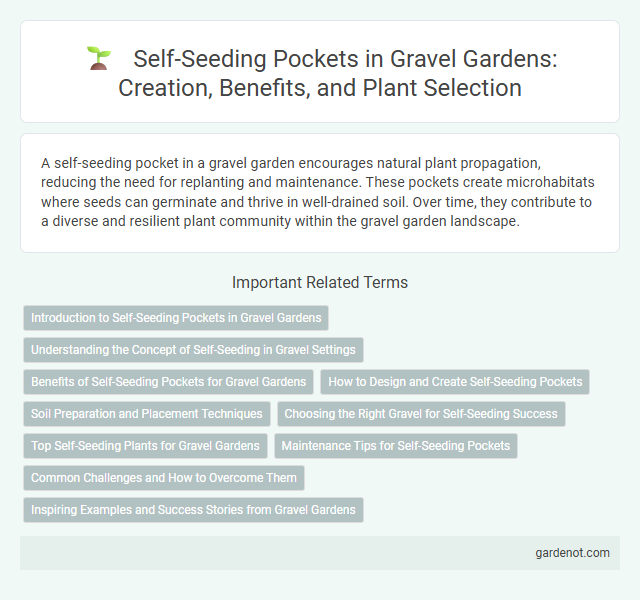A self-seeding pocket in a gravel garden encourages natural plant propagation, reducing the need for replanting and maintenance. These pockets create microhabitats where seeds can germinate and thrive in well-drained soil. Over time, they contribute to a diverse and resilient plant community within the gravel garden landscape.
Introduction to Self-Seeding Pockets in Gravel Gardens
Self-seeding pockets in gravel gardens encourage natural plant propagation by allowing seeds to disperse and germinate within small, sheltered areas. These pockets support soil retention and moisture, creating optimal conditions for hardy perennials and native wildflowers to establish themselves. Incorporating self-seeding pockets enhances biodiversity and reduces maintenance by promoting sustainable, resilient plant growth in gravel landscapes.
Understanding the Concept of Self-Seeding in Gravel Settings
Self-seeding in gravel garden settings refers to the natural process where plants drop seeds that germinate and grow without human intervention, promoting biodiversity and a dynamic landscape. Gravel gardens benefit from self-seeding species like poppies, thrift, and sedum, which thrive in well-drained, nutrient-poor soils typical of gravel. This approach reduces maintenance efforts while encouraging resilient, adaptive plant communities suited to drought-prone and sunny environments.
Benefits of Self-Seeding Pockets for Gravel Gardens
Self-seeding pockets in gravel gardens enhance plant diversity by allowing native and adaptive species to naturally propagate, reducing maintenance efforts. These pockets support soil health and promote ecosystem resilience by encouraging beneficial insects and microorganisms. Over time, self-seeding pockets create a dynamic and sustainable garden environment with improved plant coverage and aesthetic appeal.
How to Design and Create Self-Seeding Pockets
Designing self-seeding pockets in a gravel garden involves selecting hardy, drought-tolerant plants that thrive in poor soil conditions and leave space for natural seed dispersal. Create shallow depressions filled with a mix of sandy soil and organic matter to encourage seed germination while ensuring good drainage. Position pockets in sunny areas with minimal competition from dense gravel or large stones to maximize seedling establishment and garden vitality.
Soil Preparation and Placement Techniques
Self-seeding pockets thrive in well-drained, nutrient-poor soil that mimics natural gravel garden conditions, requiring minimal amendments to avoid excessive fertility. Position these pockets in sunny, sheltered areas with good air circulation to encourage seed germination and reduce moisture retention that can cause rot. Incorporating a mix of sharp sand and grit improves soil texture and supports healthy root development for robust plant establishment.
Choosing the Right Gravel for Self-Seeding Success
Choosing the right gravel for a self-seeding pocket is essential to ensure seed retention and optimal germination. Coarse-textured gravels like pea gravel or crushed stone provide excellent drainage while preventing seed washout, creating a stable environment for seedlings to establish. Selecting gravel with a mix of particle sizes helps retain moisture and supports healthy root development in gravel garden pockets.
Top Self-Seeding Plants for Gravel Gardens
Poppies, aubrieta, and candytuft rank among the top self-seeding plants for gravel gardens due to their drought tolerance and low maintenance needs. These species thrive in well-drained, rocky soils, producing vibrant blooms that naturally spread year after year. Their ability to reseed effortlessly enhances garden biodiversity and creates a dynamic, colorful landscape without frequent replanting.
Maintenance Tips for Self-Seeding Pockets
Self-seeding pockets in gravel gardens require minimal maintenance, focusing primarily on regular monitoring to prevent overcrowding and ensure healthy plant growth. Thin seedlings strategically by removing weak or excess plants to improve air circulation and reduce competition for nutrients. Incorporate light watering during dry periods and occasional weeding to maintain a balanced, thriving garden ecosystem.
Common Challenges and How to Overcome Them
Common challenges in self-seeding pockets of gravel gardens include uneven plant distribution, weed invasion, and poor seed germination due to soil compaction or insufficient moisture. To overcome these issues, ensure the soil is well-prepared by loosening and enriching it with organic matter, remove weeds regularly to reduce competition, and maintain consistent watering during the germination period. Selecting hardy, drought-resistant plants adapted to gravel garden conditions also improves success rates and promotes sustainable growth.
Inspiring Examples and Success Stories from Gravel Gardens
Self-seeding pockets in gravel gardens exemplify natural regeneration, showcasing resilient plants like Forget-me-nots and Alyssum thriving with minimal intervention. These pockets create dynamic, evolving landscapes as seeds disperse and flourish in nutrient-poor substrates, enhancing biodiversity. Successful gravel gardens from the RHS Chelsea Flower Show demonstrate how self-seeding encourages sustainable, low-maintenance greenery that adapts to harsh, dry conditions.
Self-seeding pocket Infographic

 gardenot.com
gardenot.com